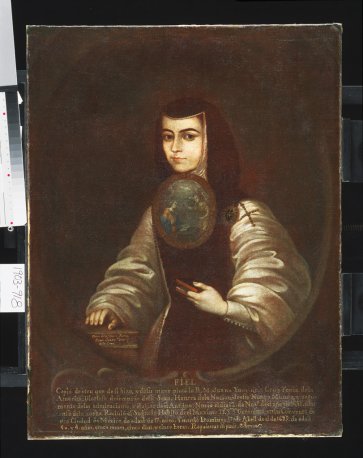Portrait of Sor Juana Inez de la Cruz
Egyptosophy
Portrait of Sor Juana Inez de la Cruz [ edit ]
Inés Ramírez de Asbaje, better known as Sor Juana Inés de la Cruz (1648/51–1695), was one of the most celebrated Novo-Hispanic writers of the seventeenth century. Termed the Phoenix of Mexico and Tenth Muse, she is highly celebrated in Spanish-speaking literary circles for her dedication to poetry, philosophical musings, and religious devotion. Sor Juana's works, stellar examples of Baroque literature in the Americas, are influenced by Hermetic philosophical currents of the seventeenth century. Her Primero Sueño (c. 1685) and Neptulo Alegórico (c. 1680) were inspired by the writings of Athanasius Kircher. In one of her Romances (no. 50) she coins a verb based on Kircher's name, "to Kircherize," referring to the act of playfully tapping into the inner workings of the cosmos by means of scientific and philosophical inquiries. The quintessential poetisa, Sor Juana Kircher's passion for Ancient Egypt and was one of the first female, American-born writers to celebrate Egypt's reputation as a land of wisdom and arcane knowledge.
This posthumous portrait depicts Sor Juana standing and looking intently at the viewer. She wears a traditional religious habit of her time, consisting of a white coif and black veil over her head, an ample and cream-colored habit covering her body, a black scapular on top of her tunic, a rosary hanging over her left shoulder, and a medallion (escudo) pinned to her habit at chest level. Medallions would often depict religious imagery and passages of the Bible and were a common part of religious attire of Hieronimite nuns during the sixteenth and seventeenth centuries in Latin America.
The works of Sor Juana Inés de la Cruz (1651–1695) were the product of a lifetime dedication to literary compositions, philosophical musings, and religious devotion. She enjoyed widespread recognition in the colony of New Spain (modern-day Mexico) and her fame spread to the Iberian peninsula, where her complete works were published in three volumes. The volume of Obras Completas is a posthumous edition (1701) of the third and last volume. It contains a collection of romances, sonnets and eulogies, as well as some devotional writings.
Most significantly, it also contains her letter Respuesta a Sor Filotea de la Cruz (Response to Sister Filotea de la Cruz), a long and passionate response to the open criticism she endured on the part of high members of the Catholic Church, at the height of her talent and fame (c. 1690–91). In the letter, Sor Juana defends her right to write freely both as a woman and as a member of a religious order, citing the reasons behind her religious and philosophical ideas and pursuits. Also, it is in the Respuesta a Sor Filotea that she gives the reader an insight into her background and childhood, and mentions Athanasius Kircher, as one of the sources she consulted for her research and compositions. The summation of Kircher's work on Egypt, Oedipus Aegyptiacus, is shown to the right, and this was probably among the books in Sor Juana's extensive library.
Date
ca. 1722
Dimensions
41 1/2 x 32 1/2 inches (105.4 x 82.5 cm)
Artist or Author
Attributed to Nicolás Enríquez de Vargas
Material
Oil on Canvas
Museum
Philadelphia Museum of Art
Accession Number
1903-918
Credit Line
The Robert H. Lamborn Collection

